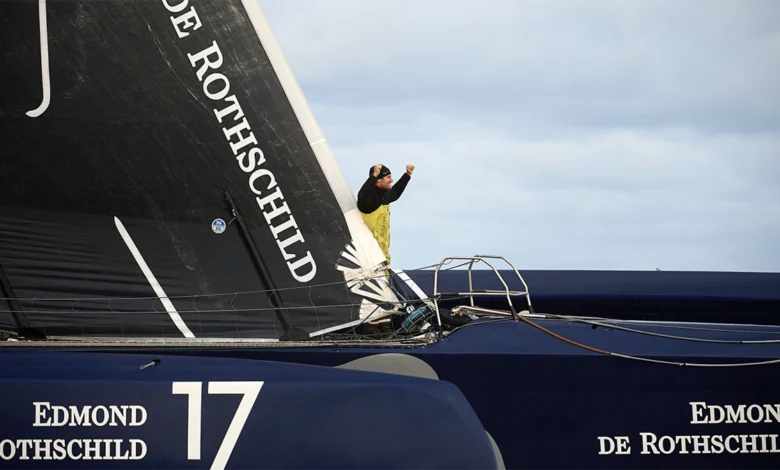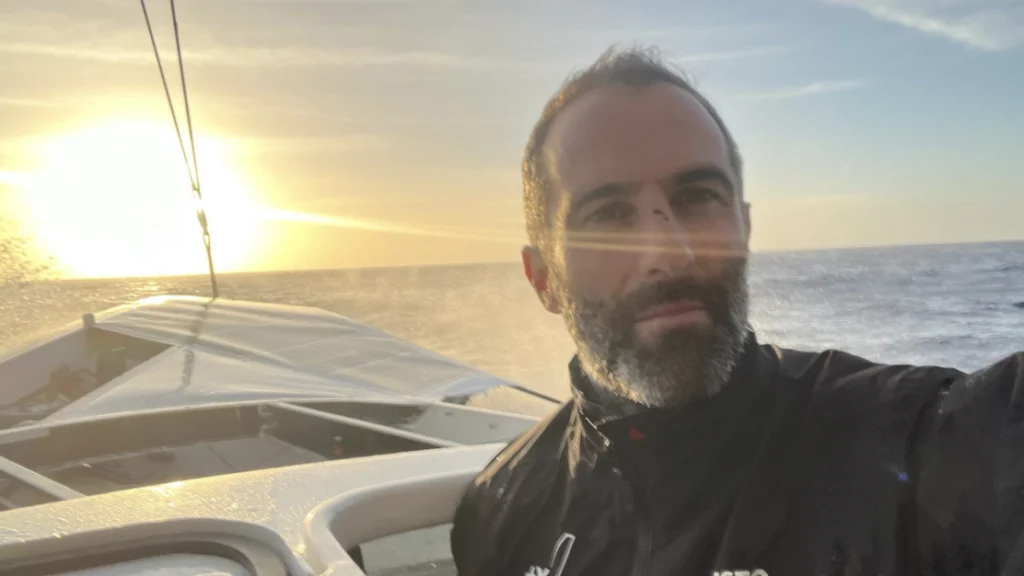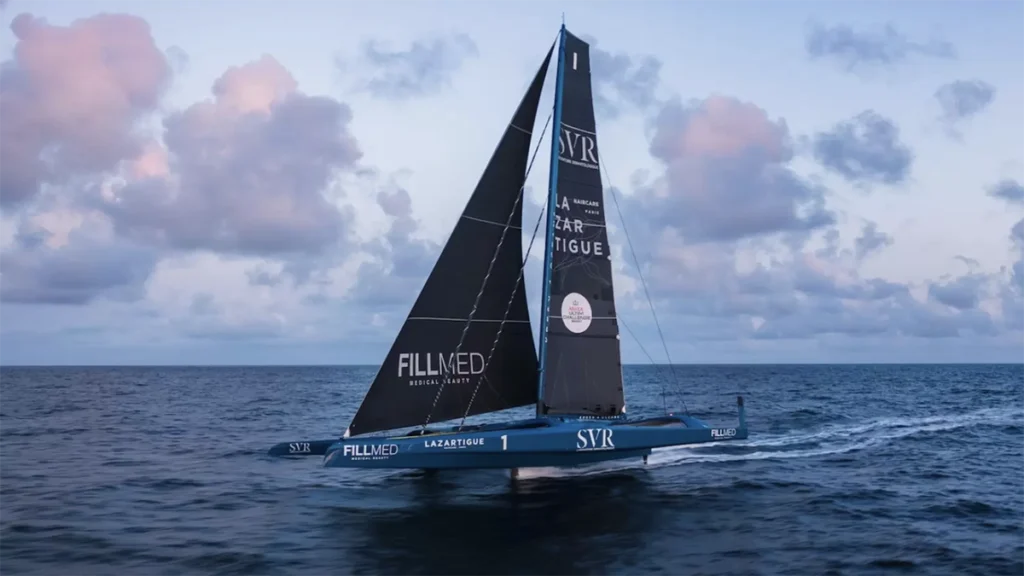
Blessed with a flawless sunrise, calm seas, and a gentle 15-knot breeze as he approached the eagerly anticipated finish line off Brest this morning, Charles Caudrelier savored the final ten miles of his solo multihull race around the world Arkea Ultim Challenge-Brest.
Having been required for many days to moderate the speed of his Maxi Edmond de Rothschild to ensure a secure victory, Caudrelier suddenly unleashed the full potential of his vessel, soaring at nearly 40 knots for a sustained period in the early morning sun. It seemed as though he wanted to remind himself, and the approximately 100,000 race enthusiasts watching online, of the sheer unbridled speed capabilities of the flying, foiling ULTIM.
One day after celebrating his 50th birthday, Caudrelier crossed the finish line off Brest at 08:37:42 local time this morning, clinching victory in the inaugural Arkea Ultim Challenge-Brest, the first-ever race around the world for 32m high-speed foiling ULTIM multihulls.
His elapsed time for the 22,460 nautical miles course, which departed from Brest on Sunday, January 7th, is 50 days, 19 hours, 7 minutes, and 42 seconds. He sailed an actual course of 28,938 miles on the water.
Following the unfortunate retirement of his closest competitor, 26-year-old Tom Laperche’s SVR Lazartigue, after striking an object on the 18th day of the race and having to withdraw to Cape Town, Caudrelier’s lead widened to the equivalent of six days at one point, as the second and third-placed skippers were forced to make consecutive technical stops in Brazil and Hobart.
Along the way he set a new solo record for the passage from Ushant to Cape Leeuwin, 18 days 5 hours 44 minutes, and for the Indian Ocean between Cape Agulhas and Tasmania’s South East Cape in a time of 8 days and 8 hours. But the Pacific Ocean was less kind to him and he had to pause just after Point Nemo – some 1300 miles west of Cape Horn – to avoid a big storm at the fearsome tip of South America.
Last week he was able to make a strategic stop into the Azores to avoid one final Biscay gale – storm Louis – before completing the final 1200 miles with this perfectly timed, perfectly executed finish this morning.
12 February 2024
Arkea Ultim Challenge-Brest, Le Cléac’h rounds Cape Horn and heads north

Second placed skipper on the Arkea Ultim Challenge-Brest solo multihull race around the world, Armel Le Cléac’h passed Cape Horn early this morning (European time/during the South American night) and then took time this afternoon to discuss his feelings after passing out of the Pacific Ocean and making the ‘left turn’ to start his ascent of the Atlantic towards the finish line in Brest, France.
Meantime fourth placed skipper Anthony Marchand completed his second technical stopover this morning, leaving Dunedin, New Zealand early this morning after making repairs to the system which hoists and lowers his remaining foil. He removed the port foil in Cape Town after it was damaged.
This morning at 05:01:50hrs UTC, that is some 34 days, 16 hours, 31 minutes and 50 seconds after leaving Brest on Sunday 7th January, Armel Le Cléac’h completed his time in the big south, passing the third of the three legendary capes of round the world racing.
The skipper of the giant blue and white Maxi Banque Populaire admitted to being a little frustrated at having crossed the Horn in the middle of the night on what is his fourth solo passage past the tip of South America. But he says he is relieved and pleased to be back in ‘inhabited’ sea areas.
“This Cape Horn is really special for me because this time I am doing it in a multihull. I have crossed it three times in a monohull, so this is my fastest time. And that feels different and it changes things up a little! And we are only the second ever to succeed in passing the Horn aboard a ‘flying’ boat. That was one of my goals.” He continues, “The Indian Ocean was very complicated, difficult, especially after Australia where I had to make tha big routing to the North of New Zealand. At once it was epic, tedious, challenging. My passage of the Pacific, on the other hand, was more classic, at the front of a depression. I made good averages, days covering 700 to 800 miles. It went by quite quickly, so much the better.”
Le Cléac’h enthused this afternoon, “I’m happy to head back north and towards home. I feel that we are leaving the big south, that we are leaving the quite difficult conditions that I have had for several days. Unfortunately, the transition will not happen immediately because there will be bad weather still for a few more days. But it feels good to see a little bit of civilization, to see land. And I feel that we are going to sail in an area where we are close to rescue, to possible logistical help with our boats. That is reassuring.”
18 January 2024
Arkea Ultim Challenge-Brest, Major Damage to the trimaran SVR Lazartigue
The ULTIM SVR-Lazartigue trimaran, currently in the South Atlantic and holding the second position in the ARKEA ULTIM CHALLENGE – Brest, experienced damage to its daggerboard following a collision at 4:30 a.m. UTC last night. Solo skipper Tom Laperche promptly notified his technical team and maintains constant communication with them. His current position is approximately 1300 miles from Cape Town.
The collision resulted in damage to the daggerboard case, causing a notable water ingress that has been stabilized. Laperche, secure and under the guidance of his technical team, is assessing the extent of the damage and planning the next steps in the coming hours.
While Tom Laperche (SVR Lazartigue) deals with the aftermath of the collision, the blue trimaran’s speed has been reduced to 13-14 knots, situated about 1200 nautical miles west of Cape Town. In contrast, race leader Charles Caudrelier (Maxi Edmond de Rothschild) is setting impressive speeds, challenging the solo 24-hour record of 851 miles set in November 2017 by Francois Gabart.
The collision abruptly ended the thrilling competition between Caudrelier and the youngest skipper in the race, 26-year-old Laperche. Reports indicate damage to the daggerboard well and significant water ingress, stabilized by watertight compartments and a pumping system evacuating water from the boat. The incident, occurring just before entering the challenging southern region, has shifted Laperche’s priorities to safety, with support from Race Direction, the SVR–Lazartigue team, and Mer Concept.
Maintaining speeds exceeding 35 knots for several hours, Charles Caudrelier is rapidly widening his lead. As of 6:00 a.m. UTC on Thursday, he covered 835 miles in the last 24 hours, nearing the 24-hour solo distance record still held by François Gabart. However, losing his closest competitor, Caudrelier is now focused on pacing himself rather than pursuing records.
The closest contender to Caudrelier is now Thomas Coville, positioned 566 miles behind Maxi Edmond de Rothschild, navigating northwest. Coville is strategically avoiding a low-pressure front, aiming to utilize southwest winds on his way to the Kerguelens. Facing the Cape of Good Hope and the ice safety barrier, multiple gybes are anticipated. Eight years ago, during his solo round-the-world record, Coville completed an extraordinary 21 gybes in 24 hours in the same region. Although not aiming to repeat such a feat, his renowned focus and work ethic remain evident.
At 1700 and 1870 miles behind the leader, Actual Ultim 3 and the Maxi Banque Populaire XI are contending with an anticyclone to the south, necessitating a more direct southward course. They anticipate riding a new depression coming in from the west after navigating the anticyclone.

